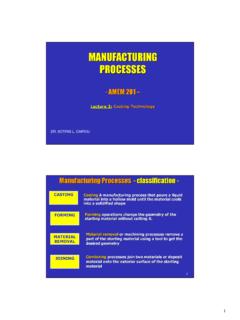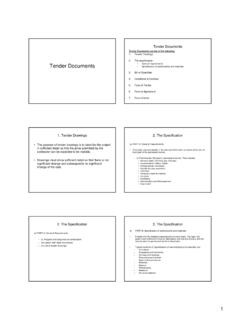Transcription of MANUFACTURING PROCESSES - FIT
1 1 MANUFACTURINGMANUFACTURINGPROCESSESPROCE SSES--AMEM 201 AMEM 201 lecture 4: lecture 4:Forming ProcessesForming PROCESSES (Rolling, Extrusion, Forging, Drawing)(Rolling, Extrusion, Forging, Drawing)DR. SOTIRIS L. OMIROU22 Forming PROCESSES Forming PROCESSES --Definition & Types Definition & Types --Forming processesare those in which the shape of a metal piece is changed by plastic deformationForming PROCESSES are commonly classified intohot-workingand cold-workingoperations. Typical forming PROCESSES are:RollingExtrusionForgingDrawing233 Forming PROCESSES Forming PROCESSES --RollingRolling--Rollingis a process of reduction of the cross-sectional area or shaping a metal piece through the deformation caused by a pair of rotating in opposite directions metal gap between the rotating rolls is less than the thickness of the entering bar therefore a friction force is necessary in order to bite the bar and to pull it through the rolls.
2 A metal bar passing through the rotating rolls is squeezed, and it elongates while its cross section area decreases. Forming PROCESSES Forming PROCESSES --RollingRolling--355A machine used for rolling metal is called rolling mill. A typical rolling mill consists of a pair of rollsdriven by an electric motor transmitting a torque through a gear and pair of cardans. The rolls are equipped with bearings and mounted in a stand with a screw-down PROCESSES Forming PROCESSES --RollingRolling--66 Rotating rolls perform two main functions:Rotating rolls perform two main functions: Pull the work into the gap between them by friction Pull the work into the gap between them by friction between workpart and rollsbetween workpart and rolls Simultaneously squeeze the work to reduce its cross Simultaneously squeeze the work to reduce its cross section section Forming PROCESSES Forming PROCESSES --RollingRolling--477 Equipment Equipment Picture 1 Picture 17 RollsRolls Housing/ StandAdjusting Screw888 Adjusting screwAdjusting screwEquipment Equipment Picture 2 Picture 25999 Pictures showing the rolling process:Pictures showing the rolling process.
3 Equipment Equipment Picture 3 Picture 31010 Types of RollingTypes of Rolling Based on workpiece geometry :Based on workpiece geometry : Flat rollingFlat rolling--used to reduce thickness of a rectangular used to reduce thickness of a rectangular cross section cross section Shape rollingShape rolling--square cross section is formed into a square cross section is formed into a shape. shape. Based on work temperature :Based on work temperature : Hot RollingHot Rolling most common due to the large amount of most common due to the large amount of deformation requireddeformation required Cold rollingCold rolling produces finished sheet and plate stock produces finished sheet and plate stock 61111 Hot rollingis a rolling operation carried out at a temperature just below the metal melting point, permitting large amount of deformation.
4 Cold rollingis a rolling operation carried out at room temperature. Cold rolling is commonly conducted after hot rolling when good surface quality and low thickness tolerance are needed. Cold rolling causes of RollingTypes of Rolling1212 Some of the steel products made in a rolling of the steel products made in a rolling Products Made of SteelRolled Products Made of Steel71313 Side view of flat rolling, indicating before and after thicknessSide view of flat rolling, indicating before and after thicknesses, es, work velocities, angle of contact with rolls, and other featureswork velocities, angle of contact with rolls, and other of Flat RollingDiagram of Flat Rolling1414 Flat Rolling TerminologyFlat Rolling TerminologyDraftDraft= amount of thickness reduction = amount of thickness reduction fottd Where, d= draft.
5 To = starting thickness;tf= final thickness81515 ReductionReduction= draft expressed as a fraction of starting = draft expressed as a fraction of starting stock thickness: stock thickness: otdr where r= reductionFlat Rolling TerminologyFlat Rolling Terminology1616 Shape RollingShape Rolling AccomplishedAccomplishedby passing work through rolls by passing work through rolls that have the reverse of desired shape that have the reverse of desired shape Products include:Products include: Construction shapes such as IConstruction shapes such as I--beams, beams, LL--beams, and Ubeams, and U--channelschannels Rails for railroad tracksRails for railroad tracks Round and square bars and rodsRound and square bars and rods91717 Rolling MillsRolling Mills Equipment is massive and expensiveEquipment is massive and expensive Rolling mill configurations:Rolling mill configurations: TwoTwo--high:high:two opposing rollstwo opposing rolls ThreeThree--high:high:work passes through rolls in both directionswork passes through rolls in both directions FourFour--high:high.
6 Backing rolls support smaller work rollsbacking rolls support smaller work rolls Cluster mill:Cluster mill:multiple backing rolls on smaller rolls multiple backing rolls on smaller rolls Tandem rolling mill:Tandem rolling mill:sequence of twosequence of two--high mills high mills 1818 Various configurations of rolling mills: (a) 2 Various configurations of rolling mills: (a) 2--high rolling rolling Rolling MillHigh Rolling Mill101919 Various configurations of rolling mills: (b) 3 Various configurations of rolling mills: (b) 3--high rolling rolling Rolling MillHigh Rolling Mill2020 Various configurations of rolling mills: (c) fourVarious configurations of rolling mills: (c) four--high rolling mill.
7 High rolling mill. FourFour--High Rolling MillHigh Rolling Mill112121 Multiple backing rolls allow even smaller roll diameters Multiple backing rolls allow even smaller roll diameters Various configurations of rolling mills: (d) cluster millVarious configurations of rolling mills: (d) cluster millCluster MillCluster Mill2222 VariousVariousconfigurations of rolling mills: (e) tandem rolling of rolling mills: (e) tandem rolling Rolling MillTandem Rolling MillRolling mills have several stages, where the each stage successively reduces the thicknessof the stock until the desired cross section is Rolling Thread Rolling --Definition Definition Deformation process used to form threads on Deformation process used to form threads on cylindrical parts by rolling them between two dies cylindrical parts by rolling them between two dies Important commercial process for mass Important commercial process for mass producing bolts and screws producing bolts and screws Performed by cold working in thread rolling Performed by cold working in thread rolling machines machines 2424 Thread rolling with flat dies.
8 (1) start of cycle, and (2) end oThread rolling with flat dies: (1) start of cycle, and (2) end of cycle. f cycle. Thread RollingThread Rolling132525 Thread RollingThread Rolling AdvantagesAdvantagesover thread cutting (machining):over thread cutting (machining): Higher production ratesHigher production rates Better material utilizationBetter material utilization Stronger threads and better fatigue resistance due Stronger threads and better fatigue resistance due to work hardeningto work hardening2626 Rolling of screw threadsThread RollingThread Rolling142727 Ring Rolling Ring Rolling --Definition Definition Deformation process in which a thickDeformation process in which a thick--walled ring of smaller walled ring of smaller diameter is rolled into a thindiameter is rolled into a thin--walled ring of larger walled ring of larger diameter diameter Applications: Applications.
9 Ball and roller bearing races, steel tires for ball and roller bearing races, steel tires for railroad wheels, and rings for pipes, pressure vessels, railroad wheels, and rings for pipes, pressure vessels, and rotating machineryand rotating machinery2828 Ring rolling used to reduce the wall thickness and increase the Ring rolling used to reduce the wall thickness and increase the diameter of a ring:diameter of a ring:(1) start, and (2) completion of process.(1) start, and (2) completion of RollingRing RollingAs thickAs thick--walled ring is compressed, deformed metal elongates, walled ring is compressed, deformed metal elongates, causing diameter of ring to be enlarged causing diameter of ring to be enlarged Hot working process for large rings and cold working process forHot working process for large rings and cold working process forsmaller ringssmaller rings152929 Forming PROCESSES Forming PROCESSES --ExtrusionExtrusion--Extrusionis a metal forming process involving shaping a metal billet (hot or cold) by forcing it through a die with an opening.
10 The two possible schemes of extrusion are presented in the picture: 3030 Forming PROCESSES Forming PROCESSES --Direct ExtrusionDirect Extrusion--The metal billet is placed to the container of the extrusion press. The die with an opening is mounted at the end of the container. When the hydraulically driven ram presses the billet, the metal starts to flow through the opening forming the extruded product of the required cross section. In the direct extrusion the extruded metal flows in the direction of the ram PROCESSES Forming PROCESSES --Indirect ExtrusionIndirect Extrusion--In the indirect extrusion the metal flows in the direction opposite to the ram motion.








